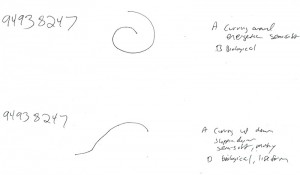Remote Viewing Protocol:
Stage 1 Revisited

The Controlled Remote Viewing protocol consists of six commonly used stages, each with its own unique objective. The objective of Stage 1 is to connect with the target. The viewer produces a quick kinesthetic response upon receiving a target reference number. This doodle is called an ideogram.
Because it is drawn reflexively by the nervous system, the ideogram is a stylized representation of the gestalt of the target or one aspect of the target. Generally, it is a simple line drawing of an angle or squiggle. The viewer then describes the overall motion and feeling of the ideogram, and concludes Stage 1 with a brief analytical label of the target—i.e., land, water, or structure.
Feeling Confident in Stage 1
The first stage—also referred to as the Ideogram A/B process or IAB—may be the least understood stage in CRV, and as a result, it is often executed incorrectly.
I have practiced remote viewing for over a decade, and until recently, I did not understand the importance of Stage 1. The initial training I received had not prepared me to successfully execute or utilize this stage. In fact, not only was I missing the point, I was taking IAB for granted.
Stages 2-6 are much better spent describing the target rather than searching for it. Stage 1 is where the rubber meets the road, and without that connection, you might end up in a ditch.
So instead of feeling confident and connected with the “signal line” from the beginning, I worked my way into the signal line—a process that at its worst might consume the entire remote viewing session.
This flawed system worked for me to a degree, but now I know that Stages 2-6 are much better spent describing the target rather than searching for it. In short, Stage 1 is where the rubber meets the road, and without that connection, you might end up in a ditch.
Being Open to the “Signal”
To be successful in Stage 1 requires receptivity and honesty—you need to be open to the signal and honest with yourself. A degree of humility is required to be able to discern subtle data that is not sourced by your ego, which may be driven by the need to be “right” or succeed.
If your analytical mind is producing the ideogram, you’re missing the objective of Stage 1. If you’re not confident that you have the signal here, then you need to start over again.
Learning to Perceive Data
Stage 1 may be the most difficult stage to teach and grasp. How do you teach someone to perceive psychic data? Any language-based attempt to teach someone to recognize a psychic data stream about a remote viewing target would be sorely inadequate. It is an inner process that cannot be expressed in language. Such data are uniquely individual—I cannot experience what you are experiencing.
To build confidence in your inner perceptions requires objective self-observation; you need to become familiar with the boundaries and language of your own inner noise before you can feel certain about new information entering your psyche.
Here we begin to enter the realms of consciousness explored in meditation, spirituality and poetry. This is also the connection, known as the Muse, which has inspired artists throughout history. The remote viewing protocol is, from this perspective, just another tool for accessing those subtle parts of our consciousness that do not communicate with the language we use daily. And, like an artist, the remote viewer objectifies the data stream.
To build confidence in your inner perceptions requires objective self-observation; you need to become familiar with the boundaries and language of your own inner noise before you can feel certain about new information entering your psyche. There are many ways to explore one’s psyche, including sensory deprivation, meditation, chanting, altered states of consciousness, etc. It may take some time and practice, but don’t be discouraged. It will pay off!
Post Your Comment on Facebook
Powered by Facebook Comments